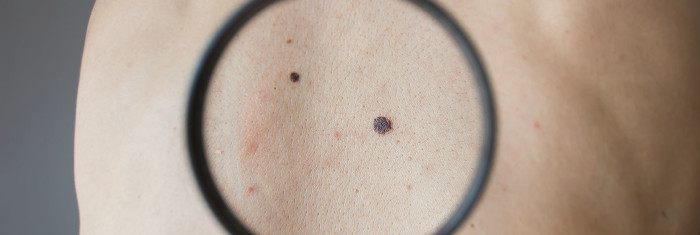
Types of Skin Cancer
A common concern that brings people to Platinum Dermatology is skin irregularities that patients fear may be cancerous or pre-cancerous. Their concern is well merited, as you can see from these statistics released by Cancer Council Australia (CCA):
- In 2012, 2,036 people died from skin cancer in Australia.
- Over 434,000 people are treated for one or more non-melanoma skin cancers in Australia each year.
- From 1982 to 2010 melanoma diagnoses increased by around 60%.
- From 1998 to 2007, consultations to treat non-melanoma skin cancer increased by 14%, to reach 950,000 visits each year.
Sun-loving Australians have the highest rate of skin cancer in the world. The CCA reminds us that
“The sooner a skin cancer is identified and treated, the better your chance of avoiding surgery or, in the case of a serious melanoma or other skin cancer, potential disfigurement or even death.”
In this article, the skin specialists at Platinum Dermatology help you take a close look at types of skin cancers and offer advice on how to proceed if you have concerns.
Platinum Dermatology’s Explains the 3 Types of Skin Cancer
The skin is made up of three types of cells: basal, melanocytes, and squamous. Skin cancers are classified in three ways, depending on which type of cell is affected:
- Melanoma – considered the most deadly form of skin cancer
- Basal Cell Carcinoma – the most common type of skin cancer
- Squamous Cell Carcinoma – second most common type of skin cancer
Squamous cell and basal cell carcinoma are collectively referred to as non-melanoma skin cancer.
A Guide to Basal Cell Skin Cancer Identification
Below is a guide to basal cell carcinomas that affect Platinum Dermatology patients. It is by far the most common form of skin cancer, appearing on the face, head, neck, and trunk, and other parts of the body likely to have been over-exposed to the sun.
- Nodular & Nodular-Ulcerative – Round, hard, red or red-grey pearly bumps, which might continue to extend and ulcerate if left untreated.
- Pigmented – Similar to nodular BCC, but it has areas of pigmentation (darker areas) and can be confused with melanoma.
- Superficial – Occurs mainly on the trunk as a red patch, usually up to 3cm in diameter. The edge of these tumours can be difficult to distinguish.
- Morphoeic – Looks like a firm yellow-white scar-like area and is often mistaken for one. They are bigger (deeper) than they first appear to the naked eye and may require special treatment techniques such as Mohs’ Surgery.
Although basal cell carcinoma is rarely a threat to life, if left untreated it can grow and affect adjoining skin and structures. Loss of the nose, ear, and eye can occasionally occur if this skin cancer is not addressed. In our experience, in most cases, basal cell carcinoma is curable.
Additionally, with the aesthetic expertise offered by the skin specialists at Platinum Dermatology, it is possible to achieve excellent cosmetic results.
A Dermatologist Reviews Squamous Cell Carcinoma
The second most common form of skin cancer is the SCC.
SCC’s usually form a scaly, quickly growing pink lump or wart-like growth, which can also break down, crust, bleed and ulcerate. They can be tender, or cause a burning or stinging sensation. Like basal cell carcinoma, they most commonly occur on areas exposed to a lot of sunlight.
People who have had organ transplants or medications to suppress their immune system for other reasons are at higher risk of developing SCCs.
Platinum Dermatology Warns of Malignant Melanoma
Malignant melanomas occur on sun-exposed skin, but they may also develop on skin that is generally covered, but has been sunburned in the past. Melanomas either develop from an existing mole or appear as a new brown, red or black spot which changes and grows in size.
Malignant melanomas can spread throughout the body and cause death, making early diagnosis and prompt treatment by experienced doctors such as you’ll find at Platinum Dermatology essential.
Is It Time to Get a Skin Cancer Assessment At Platinum Dermatology?
Skin cancer lesions generally stand out as being quite different to surrounding skin. A change in the colour, size, or shape of an existing spot on the skin may signal the development of skin cancer. The disease may also appear as a new and unusual looking spot.
If a spot strikes you as being a bit odd, take it seriously. We urge you to contact Platinum Dermatology immediately on 02 8014 6500 or use the contact form on this page to schedule an appointment for a skin check at our practice.
